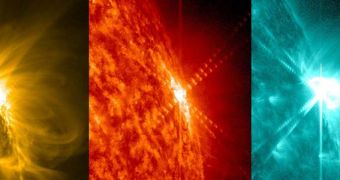NASA astronomers operating the Solar Dynamics Observatory (SDO) satellite report that the Sun released a new medium-class solar flare on Wednesday, March 12. The event, while classified as being of moderate intensity, was extremely powerful for its class, nearing an X-class classification. Scientists say that the flare will most likely not affect Earth directly.
The phenomenon peaked at 6:34 pm EDT (2234 GMT), and SDO was able to observe it in multiple wavelengths, as seen in the image above. According to Space Weather Prediction Center at the US National Oceanic and Atmospheric Administration (NOAA), the flare registered as an M9.3 event.
Solar emissions are classified based on a system where an M2 flare, for example, is twice as powerful as an M1 event, and so on. Beyond M10, flare intensity levels enter the X class, which is reserved for only the most powerful events. The latest flare was produced by an active, complex and magnetically-strong region on the Sun called AR 11996.
SDO did not determine if a coronal mass ejection (CME) accompanied the event or not. Until now, the SWPC has released no warning related to the emission of highly charged clouds of solar particles that might affect Earth over the next couple of days. CME are dangerous because they create particles and radiations that can harm satellites, power grids, and affect the International Space Station.

 14 DAY TRIAL //
14 DAY TRIAL //